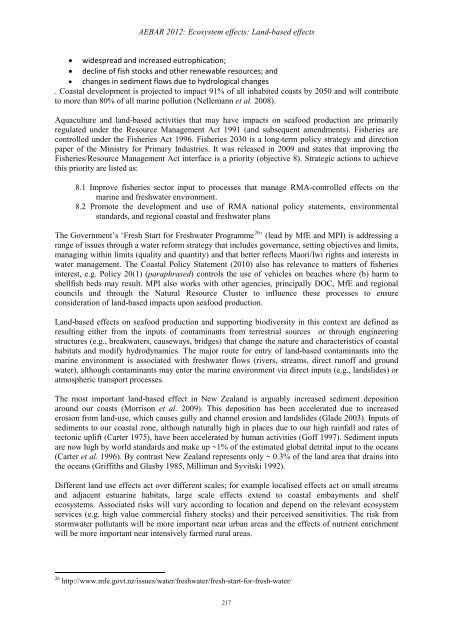Aquatic Environment and Biodiversity Annual Review 2012
Aquatic Environment and Biodiversity Annual Review 2012
Aquatic Environment and Biodiversity Annual Review 2012
You also want an ePaper? Increase the reach of your titles
YUMPU automatically turns print PDFs into web optimized ePapers that Google loves.
AEBAR <strong>2012</strong>: Ecosystem effects: L<strong>and</strong>-based effects<br />
• widespread <strong>and</strong> increased eutrophication;<br />
• decline of fish stocks <strong>and</strong> other renewable resources; <strong>and</strong><br />
• changes in sediment flows due to hydrological changes<br />
. Coastal development is projected to impact 91% of all inhabited coasts by 2050 <strong>and</strong> will contribute<br />
to more than 80% of all marine pollution (Nellemann et al. 2008).<br />
Aquaculture <strong>and</strong> l<strong>and</strong>-based activities that may have impacts on seafood production are primarily<br />
regulated under the Resource Management Act 1991 (<strong>and</strong> subsequent amendments). Fisheries are<br />
controlled under the Fisheries Act 1996. Fisheries 2030 is a long-term policy strategy <strong>and</strong> direction<br />
paper of the Ministry for Primary Industries. It was released in 2009 <strong>and</strong> states that improving the<br />
Fisheries/Resource Management Act interface is a priority (objective 8). Strategic actions to achieve<br />
this priority are listed as:<br />
8.1 Improve fisheries sector input to processes that manage RMA-controlled effects on the<br />
marine <strong>and</strong> freshwater environment.<br />
8.2 Promote the development <strong>and</strong> use of RMA national policy statements, environmental<br />
st<strong>and</strong>ards, <strong>and</strong> regional coastal <strong>and</strong> freshwater plans<br />
The Government’s ‘Fresh Start for Freshwater Programme 26 ’ (lead by MfE <strong>and</strong> MPI) is addressing a<br />
range of issues through a water reform strategy that includes governance, setting objectives <strong>and</strong> limits,<br />
managing within limits (quality <strong>and</strong> quantity) <strong>and</strong> that better reflects Maori/Iwi rights <strong>and</strong> interests in<br />
water management. The Coastal Policy Statement (2010) also has relevance to matters of fisheries<br />
interest, e.g. Policy 20(1) (paraphrased) controls the use of vehicles on beaches where (b) harm to<br />
shellfish beds may result. MPI also works with other agencies, principally DOC, MfE <strong>and</strong> regional<br />
councils <strong>and</strong> through the Natural Resource Cluster to influence these processes to ensure<br />
consideration of l<strong>and</strong>-based impacts upon seafood production.<br />
L<strong>and</strong>-based effects on seafood production <strong>and</strong> supporting biodiversity in this context are defined as<br />
resulting either from the inputs of contaminants from terrestrial sources or through engineering<br />
structures (e.g., breakwaters, causeways, bridges) that change the nature <strong>and</strong> characteristics of coastal<br />
habitats <strong>and</strong> modify hydrodynamics. The major route for entry of l<strong>and</strong>-based contaminants into the<br />
marine environment is associated with freshwater flows (rivers, streams, direct runoff <strong>and</strong> ground<br />
water), although contaminants may enter the marine environment via direct inputs (e.g., l<strong>and</strong>slides) or<br />
atmospheric transport processes.<br />
The most important l<strong>and</strong>-based effect in New Zeal<strong>and</strong> is arguably increased sediment deposition<br />
around our coasts (Morrison et al. 2009). This deposition has been accelerated due to increased<br />
erosion from l<strong>and</strong>-use, which causes gully <strong>and</strong> channel erosion <strong>and</strong> l<strong>and</strong>slides (Glade 2003). Inputs of<br />
sediments to our coastal zone, although naturally high in places due to our high rainfall <strong>and</strong> rates of<br />
tectonic uplift (Carter 1975), have been accelerated by human activities (Goff 1997). Sediment inputs<br />
are now high by world st<strong>and</strong>ards <strong>and</strong> make up ~1% of the estimated global detrital input to the oceans<br />
(Carter et al. 1996). By contrast New Zeal<strong>and</strong> represents only ~ 0.3% of the l<strong>and</strong> area that drains into<br />
the oceans (Griffiths <strong>and</strong> Glasby 1985, Milliman <strong>and</strong> Syvitski 1992).<br />
Different l<strong>and</strong> use effects act over different scales; for example localised effects act on small streams<br />
<strong>and</strong> adjacent estuarine habitats, large scale effects extend to coastal embayments <strong>and</strong> shelf<br />
ecosystems. Associated risks will vary according to location <strong>and</strong> depend on the relevant ecosystem<br />
services (e.g. high value commercial fishery stocks) <strong>and</strong> their perceived sensitivities. The risk from<br />
stormwater pollutants will be more important near urban areas <strong>and</strong> the effects of nutrient enrichment<br />
will be more important near intensively farmed rural areas.<br />
26 http://www.mfe.govt.nz/issues/water/freshwater/fresh-start-for-fresh-water/<br />
217

















